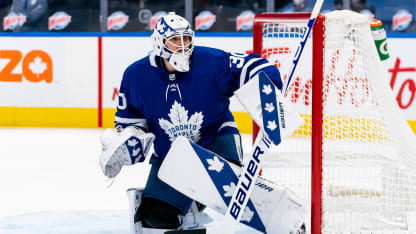This season could be one of the exceptions to the rule, much like last season.
Injuries to goalies, an added emphasis on depth, and a number of experienced NHL goalies on expiring contracts could combine to change the dynamic of the 2021 NHL Trade Deadline, which is 3 p.m. ET on April 12.
It could look more like last season, when five goalies were traded within a month of the 2020 NHL Trade Deadline, with four having made a positive impact since. That's more goalies traded than leading up to any of the five previous deadlines, and a bigger impact than those five deadlines combined.
Robin Lehner was traded from the Chicago Blackhawks to the Toronto Maple Leafs and then to the Vegas Golden Knights on Feb. 24, 2020. He helped the Golden Knights reach the Western Conference Final and signed a five-year contract with Vegas on Oct. 3, 2020.
Goalie Malcolm Subban, who was traded to the Blackhawks as part of the deal, is the backup for Chicago this season.
The Colorado Avalanche acquired
Michael Hutchinson
from the Toronto Maple Leafs on Feb. 24, 2020. The Avalanche wanted Hutchinson for depth entering the Stanley Cup Playoffs, but he became the starter against the Dallas Stars in the Western Conference Second Round because of injuries to Philipp Grubauer and Pavel Francouz. Hutchinson helped twice stave off elimination before the Avalanche lost in Game 7.
Hutchinson was available because the Maple Leafs had acquired goalie Jack Campbell as part of a trade with the Los Angeles Kings on Feb. 5, 2020. This season Campbell has been invaluable for the Maple Leafs, setting a Toronto Maple Leafs record with a 10-game winning streak and playing the No. 1 role while Frederik Andersen is out with a lower-body injury.
Those success stories could help create more trades involving goalies this season, perhaps helping to dispel some of the very real concerns about goalies switching teams during the season.
Eddie Lack played for four teams during his five-season NHL career before he retired last season because of a hip injury. In his final NHL season, 2017-18, he was traded from the Calgary Flames to the New Jersey Devils on Dec. 30, 2017.
"The hardest part for a goalie coming in the middle of a season is you have to get used to a new system, a new goalie coach, a new everything," Lack said. "It's a little easier as a [skater] when you're coming in as a rental to have success. But as a goalie it takes a while to create that bond with your defense and teammates, and I feel like 1-2 months before the playoffs is not enough time to really settle in."
The impact of a goalie with a new team after the deadline could be impacted by several factors.

